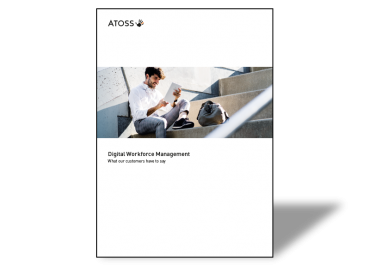Why companies should shift their HR processes to the cloud
Are you hesitating? Then you’re probably not alone. Especially when it comes to sensitive personnel data, are you harboring doubts about cloud solutions? In actual fact, there is no reason for this. Instead, there are many good arguments in favor of SaaS (Software as a Service) solutions for business software - also in the area of human resources.
On the safe side with a cloud solution
Probably the most important point when it comes to the use of business applications: IT security. Especially in workforce management, where employee master data, time-management information such as presence and absence, as well as data from workforce scheduling and access management are stored and archived, the entire data and also the operation of the solution must be secured in the best possible manner. In many companies, fear of a cyber-attack or possible data loss is omnipresent.
A quick look at the report on the state of IT security in Germany 2020 confirms this concern with some hard facts and figures. According to the report, 117.4 million new malware variants were registered, an average of 322,000 per day. In the preface to the report, Federal Minister of the Interior Horst Seehofer emphasizes: "Depending on the extent of the infection, commercial enterprises can experience short-term work and production restrictions or even a complete failure for several weeks or months.” In order to avoid this, safety precautions are needed in various places. So let's go through the most vital ones.
Data Center Security
According to BSI, this includes "permanent monitoring of access [...] and trained security personnel. Supply components that are essential for operation should be designed redundantly, such as power supply, air conditioning and Internet connection. Modern fire safety precautions must also be implemented and regularly tested". Security is upped one step further by geo-redundancy. This means that data centers are "geographically sufficiently distant from each other so that a particular damaging event [...] does not simultaneously affect the data center originally used and the one in which the backup capacity is used."
Server Security
It states that "standard measures should be implemented to protect IT systems, such as host firewalls, host-based intrusion detection systems, etc., and regular integrity checks of important system files should be performed.” The foundation for reliable and secure provisioning is also a broadband connection, standardized and widely used transmission protocols, a service-oriented architecture and, above all, consistent virtualization.
Network Security
Security is essential in defending against network-based attacks. This includes security measures against malware, i.e. virus protection, Trojan detection, spam protection, but also security concepts such as IPS/IDS systems, firewalls or application layer gateway. In addition, the defense against DDoS attacks should be considered and the communication between provider and user must be encrypted, for example via SSL. These are only a few essential criteria that you should consider when choosing a provider. A detailed list of all BSI recommended criteria can be found here.

Digital workforce management from the cloud? You can find out more HERE.
Application security
Vital in this context: Security must be part of the Software Development Life Cycle process, i.e. reviews, automated tests, vulnerability tests, etc. are performed regularly. In addition, regular and rapid patch and change management for software updates significantly contributes to the security of the hosted solution.
Data security
This is an important issue, especially in the context of highly sensitive personnel data. Security must be guaranteed throughout the entire data life cycle - from creation all the way through to deletion. Secure isolation of the data is also a basic prerequisite. Keywords here include virtual storage areas or tagging. Regular data protection via backups is another essential aspect. Here, too, defined basic conditions are called for, e.g. scope, intervals, times and duration of storage. And finally, the provider must always ensure that the data can be entirely deleted at the customer's request.
Your company is in good hands with a provider that can meet these points. The security of your IT solution is usually even significantly higher than with an on-premise solution. That's why the path to the cloud may represent a major step for many companies, but it's worth it in the end.
Cloud applications save resources
When IT solutions are installed and managed in your own company, this initially entails an investment - in time and resources. On the one hand, the IT infrastructure must always be highly up-to-date to ensure security and availability. On the other hand, the valuable resource of IT employees, who hold the necessary and often cost-intensive specialist know-how, is limited.
A SaaS solution relieves the IT department given that the provider takes care of hosting, operating and managing the software. This also includes continuous monitoring of ongoing system operation as well as regular updates, thereby ensuring operational reliability and the long-term success of the solution.
A SaaS solution relieves the IT department given that the provider takes care of hosting, operating and managing the software.
Greater cost transparency and scalability
Greater cost transparency is achieved through monthly billing according to the "pay for what you use" principle and the elimination of separate license and support costs for database, application and backup servers. It is also important to select components that are optimally matched to the respective application. This entails insights, know-how and values gained through experience values that often only the software manufacturer itself can provide. You only use and pay for the components or modules that you actually need.
Consequently, you can rely on a backend IT infrastructure that is optimally adapted to the solution and can be scaled as required, resulting in optimized system performance while saving additional IT resources. All of the costs incurred for the operation of the cloud solution can be accurately forecast.

You want to learn more about digital workforce management? Then you are welcome to take a look at our website
Conclusion: Cloud solutions guide HR safely and securely into the future
With SaaS you always have your finger on the pulse of the times – which is why the future of digital workforce management lies in the cloud. And integration into a holistic HR solution is no problem either. ATOSS Workforce Management, for example, can be fully and seamlessly integrated into SAP SuccessFactors Employee Central. Functions, information and use cases can be accessed and processed directly under the SAP SF EC interface - without the need to log in again. Likewise, there is no need for duplicated data maintenance, while end users enjoy has a central access point that is defined by a sophisticated access authorization system. The result is a powerful platform in the cloud capable of end-to-end mapping of all HR processes end-to-end.
Learn more about our customers who are already successfully using the cloud in our current best-of brochure.





